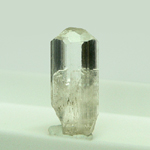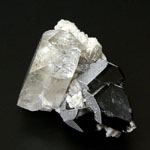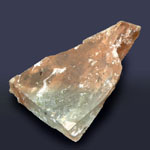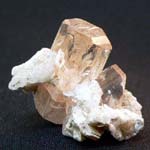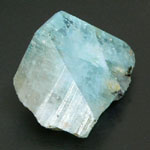Stone, minerals and semiprecious of the world stone
Silicate: Topaz -->rus
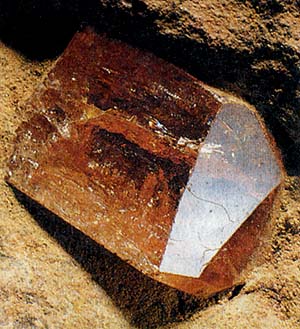 Diagnostic cart.
Diagnostic cart.
On a photo. Two different crystallography types of topaz
Al2 Fe2 SiO4
Crystal structure rhombic
Hardness on the Mohs scale 8
Specific unit weight mass 3,49-3,6
Cleavage perfect absolute
Fracture, break padman
Colors colourless, polycoloured (multicoloured)
Colors in powder triturate white
Glance (glitter, glare) glassy
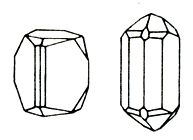
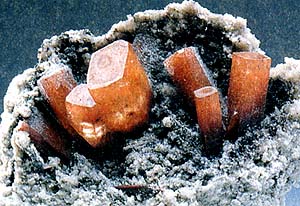 Before topazs were name all of golden-brown, wine, white hard stone. The name arose up from the ancient name of island of Zeberget - Topazos. Topazs usually are not bright, more frequent than all they are golden-yellow with a rose tint. Rose topazs are most valued.
Before topazs were name all of golden-brown, wine, white hard stone. The name arose up from the ancient name of island of Zeberget - Topazos. Topazs usually are not bright, more frequent than all they are golden-yellow with a rose tint. Rose topazs are most valued.
Under the action of sunlight the color of stone grow pale and disappears gradually. The color of blue topazs is more steady. Quite often there is the sectorial distributing of colouring in topazs: the blue and rose pyramids of growth alternate in one crystal. From perfect cleavage it is not necessary to scratch topaz for determination hardness. It requires a very careful appeal at polishing and apartment in a frame. Topaz is sensible and to influence of sulphuric acid.
There are very large and heavy crystals of topaz in nature: in 1965 in Ukraine (Europe, CIS) topaz was found by mass over 100 kg In Washington, in Smitsonovskom institute, the cut topaz is kept in a few thousand carats.
At polishing of the coloured topazs the step cutting or cutting wedges is used more frequent than all, for colourless differences the brilliantine diamond cutting is optimum. Stone, muddy including, polish cabochons.
Topaz - one the hardest minerals: it scratches Quartz and scratches a corundum. A mineral is heavy, fragile frail brittle, possesses perfect cleavage parallell to bottom base. Transparent, brilliance of glassy. In nature often be found as well well-educated crystals of short-prismatic type with the typical for him vertical shading on verges. Colouring is changeable, that is conditioned the presence of admixtures of oxides of iron and chrome.
Chemical composition (chemistry, compound) is maintenance (in %): A2O3 - 48,2-62; SiO2-28,2-39; F - 13-20,4; H2O to 2,45; the admixtures of iron, chrome, magnesium, titan, vanadium are marked. Crystal structure - rhombic, rhombo-dipyramid, bipyramid type of symmetry. Cleavage - perfect absolute to on (001), not clear to on (101) and (011). Colourless, white, light-blue, rather yellow, wines-yellow, gold, pink, rose; the zonality of colouring is characteristic.
Diagnostic indication.
Topaz is not added the action of acids (except for by a chamois), refractory. In some his differences, colouring can disappear under the action of sunlight or warmth; in other heating, vice versa, strengthens reddish-brown tone. Topaz is the unique natural semiprecious stone, having identical specific gravity with a diamond.
Topazs are alike outwardly on many minerals, such as Apatite, Aquamarine, Beryl, Brasilianite, Chrysoberyl, citrine, Tourmaline, sometimes even diamond. Famous colourless topaz of "Braganca" by mass 1640 carat, decorating the crown of Portugal, long time considered a diamond. Additional difficulties in diagnostics of topazs arise up in those cases, when stone are artificially painted by heating. Yellow topazs become rose here, blue or colourless. Unlike actings to the market imitations - citrine or burnt Amethysts, purchasing a gold yellow color, which name gold or by Madeira -Topaz, - veritable natural topazs name noble topazs.
Origin provenance genesis.
It typical mineral pegmatite-pneumatolysis genesis which appears in small emptinesses and veins of rocks of granit type.
Deposit minefield mine field occurrence subsoil.
The richest deposits are disposed in Brazil on territory of the state of Mi-nas-zherays and regions of Te-ofilo-ottoni and Serro. Other large deposits of topaz are in Pakistan, Ukraine, on Ural, in Mexico, Sri Lanka, on Madagascar and in Nigeria. In Italy found out small colourless and rose crystals on an island Elba and in the quartz porphyries of Guasso-al-Monte (province Varese).
The primary deposits of topaz are timed to pegmatites and greisen, second - to the mineral deposits. In XVIII century to the known deposits of topaz in Europe Shnekkenshtein belonged in the saxon Ore mountains (presently declared the monument of nature). Today the most considerable deposits of topazs are in Brazil (Minas-zherays, Espiritu-santu), Sri Lanka, Burma and in the CIS (Ural, Transbaikalia (Zabaykale), Ukraine). There are topazs and in Australia, Japan, on Madagascar, in Mexico, Nigeria, Zimbabwe, Namibia and USA. Light blue topazs are known in North Ireland. To Scotland, England (Kornuoll).
The use is on jeweller business..
Topaz - one of the most widespread and popular jeweller stone. From deep antiquity he right serves a noble purpose - happy us the beauty. For topaz, cutting is more frequent than all used a classic oval, very friendly to the exposure of game of light. The also mixed cuttings are used, such as a rectangular plate and steps. Cutting in cabochon, which is used for opaque topazs, is less widespread. The so-called polychromatic stone at which one part can be blue type at oneself very beautifully, and other - by wine.
